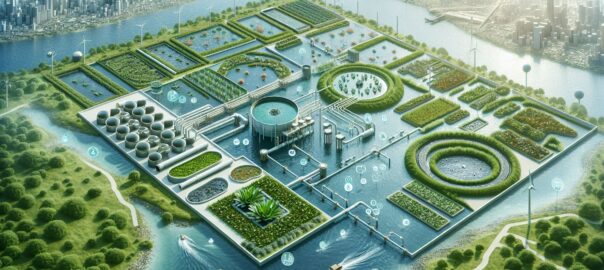Water is the lifeblood of our planet, fundamental to every ecosystem and community. Yet, with increasing urbanization, industrialization, and climate change, the strain on water resources is greater than ever. One of the major challenges is dealing with wastewater – the used water that comes from homes, businesses, industries, and storm drains. An integrated wastewater treatment system is a holistic approach to managing and treating this water to protect public health and the environment. In this article, we’ll explore what an integrated wastewater treatment system is, its components, benefits, real-world applications, and future trends.
What is an Integrated Wastewater Treatment System?
An integrated wastewater treatment system (IWTS) is a framework that brings together various processes and technologies to treat wastewater efficiently and effectively before releasing it back into the environment or reusing it. The core idea is to integrate multiple stages of wastewater management, including collection, treatment, and disposal or reuse, in a synchronized manner.
Components of an IWTS
-
Wastewater Collection: The system begins with a network of pipes and pump stations that collect wastewater from residential, commercial, industrial, and stormwater sources.
-
Preliminary Treatment: The collected wastewater undergoes preliminary treatment to remove large solids and grit that could damage equipment or hinder further treatment processes.
-
Primary Treatment: Next, sedimentation or flotation processes allow suspended solids to settle out or float to the surface, where they can be removed.
-
Secondary Treatment: Using biological processes, microorganisms break down organic material in the wastewater.
-
Tertiary Treatment: Advanced treatment methods, such as filtration, disinfection, and nutrient removal, further purify the water to meet regulatory standards or specific reuse requirements.
-
Sludge Treatment: The solids removed during the different stages are treated and processed into biosolids, which can be used as fertilizer or disposed of safely.
-
Effluent Disposal or Reuse: Treated water (effluent) is either discharged to surface water bodies, reused in applications like agriculture and industry, or replenished into groundwater systems.
-
Monitoring and Control: Throughout these stages, integrated monitoring and control systems ensure that processes operate correctly and efficiently.
Benefits of an IWTS
An IWTS provides numerous benefits:
- Environmental Protection: It reduces the release of contaminants into natural water bodies, thus protecting ecosystems.
- Resource Recovery: Nutrients, energy, and water can be recovered for beneficial use, promoting sustainability.
- Cost Efficiency: Integrated systems optimize resource usage, leading to financial savings in the long run.
- Compliance with Regulations: They ensure that the treated water meets environmental standards and regulations.
- Adaptability: Flexible design allows adaptation to varying wastewater volumes and compositions.
- Public Health: By removing pathogens and pollutants, IWTSs prevent waterborne diseases.
Real-World Application and Case Study
One notable example of an integrated wastewater treatment system is the NEWater project in Singapore. The small island nation faced water scarcity due to its limited size and lack of natural resources. To tackle this issue, Singapore’s Public Utilities Board (PUB) invested in an advanced water recycling and treatment solution that includes:
- Microfiltration/ultrafiltration: Removes suspended solids, microbial pathogens, and some viruses.
- Reverse osmosis: A membrane process that eliminates contaminants, including salts and pharmaceuticals.
- Ultraviolet disinfection: Ensures the remaining microorganisms are inactivated.
NEWater has become a benchmark for integrated wastewater treatment and recycling, providing up to 40% of Singapore’s water needs and aiming for 55% by 2060.
Source: “Creating NEWater”
Future Trends
As technology evolves, IWTSs are likely to incorporate more innovations:
- Internet of Things (IoT): Deploying sensors that provide real-time data on system performance and help in proactive maintenance.
- Artificial Intelligence (AI) and Machine Learning (ML): Predictive analytics for optimizing treatment processes and reducing energy consumption.
- Media article on advanced bioreactors that reduce the footprint while enhancing treatment capability.
- Resource Recovery Facilities: Pursuing a zero-waste approach by extracting valuable products from wastewater.
- Regenerative Design: Mimicking natural processes to create resilient and self-sustaining treatment systems.
Conclusion and Call to Action
Integrated wastewater treatment systems are the cornerstone of sustainable water management, providing clear benefits to the environment, society, and the economy. As our water challenges grow more complex, embracing these integrated solutions becomes imperative.
Further Reading and Resources
Here are some authoritative sources that can help you understand IWTSs better:
- “Wastewater Treatment for Pollution Control and Reuse” by Syed R. Qasim
- “United States Environmental Protection Agency (EPA) – Wastewater Technology Fact Sheet” – Offers a comprehensive look at the technologies used in wastewater treatment.
- “Water Environment Federation (WEF) – Water Quality & Technology” – Provides resources and publications on the latest innovations in water and wastewater treatment.
Water is essential to life. By investing in integrated wastewater treatment systems, communities can ensure water sustainability for current and future generations. As a call to action, encourage local stakeholders and policymakers to consider these integrated solutions for efficient and sustainable wastewater management.
